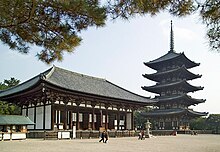Kofuku-ji
Kōfuku-ji ( Japanese 興福寺 ) is a Buddhist temple in the city of Nara in Japan .
history
It is one of the main temples of the Hossō-shū , which is believed to have originated in Yamashina-ku , a district of Kyoto , where it is said to have been founded by members of the Fujiwara clan 669 as Yamashina-dera ( 山 階 寺 ). In 672, when the Jinshin Civil War also took place, it is said to have been relocated as Umayasaka-dera ( 厩 坂 寺 ) to Asuka or in the area of the later Fujiwara-kyō in what is now Nara Prefecture .
What is certain is that when the capital was moved to Nara (then Heijō-kyō ) it was rebuilt there in 710 at the beginning of the Nara period as Kōfuku-ji.
In the second half of the Heian period , the Kofuku-ji gained massive influence and various large temples came under his control, including the Yakushi-ji , the Hōryū-ji , the Saidai-ji , the Daian-ji and the Kiyomizu-dera .
In 1180 the Kōfuku-ji was destroyed in the course of the Gempei War along with some others in Nara by the army of Taira no Kiyomori , as he had participated on the side of Minamoto no Yorimasa in the Heiji rebellion against the Taira . After the war, the temple was rebuilt with private funding from the Fujiwara.
During the Kamakura period and the Muromachi period , Kofuku-ji was declared by the respective shogunate to be the protective temple of Yamato Province . On the side of the Jimon branch of the Tendai-shū from the Mii-dera , the temple participated in various warlike Sōhei disputes with the Sanmon branch of the Tendai-shū from the Enryaku-ji together with the Tōdai -ji .
From a religious point of view, the Miroku cult was particularly popular on the Kofuku-ji during the Kamakura period .
In the early Meiji period , however, the temple was severely neglected and largely expropriated due to the general elevation of Shinto to the state religion and the decree to separate Buddhism and Shinto. It could only be preserved with need.
In 1892 the Kōfuku-ji was made into one of the three main temples of the Hossō-shū along with Yakushi-ji and Hōryū-ji, and a common chief was appointed for all three. At that time, the Hossō-shū only had about 40 branch temples.
buildings
The most famous buildings of the temple are:
- the three main golden halls (whose names are derived from their location in the temple complex), all of which are part of the national treasures of Japan and contain many sculptures and altars, some of which are also important national treasures .
- Hokuendō ( 北 円 堂 , 34 ° 41 ′ 0.4 ″ N , 135 ° 49 ′ 47.8 ″ E ), the northern, octagonal hall, which shows the first traces of the Daibutsuyō style, built in 721 by the Empresses Gemmei and Genshō , the current building is a reconstruction from 1210.
- Tōkondō ( 東金堂 , 34 ° 40 '58.4 " N , 135 ° 49' 56" O ), the eastern hall, a national heritage with many important shrines and relics inside, built in 726 on command from Kaiser Shōmu moved , supposedly to speed up the recovery of Empress Genshō . The current building is a reconstruction from 1415.
- The central hall Chūkondō ( 中 金堂 , 34 ° 40 ′ 59.5 ″ N , 135 ° 49 ′ 52.7 ″ E ), built from 710 to 724 by Fujiwara no Fuhito , was restored in 1819. In 1974 a temporary main hall was built to the north, into which the relics were transferred. In 2000, the Chūkondō was dismantled for rebuilding and in 2010, on the 1300th anniversary of the temple, the rebuilding began, which is to last until autumn 2018.
- the Sanjūnotō ( 三重 塔 , 34 ° 40 ′ 56.1 ″ N , 135 ° 49 ′ 46.9 ″ E ), a three-story pagoda , built in 1143 on the orders of Emperor Sutoku . The current building is a reconstruction from the early years of the Kamakura period .
- and the Gojūnotō ( 五 重 塔 , 34 ° 40 ′ 56.9 ″ N , 135 ° 49 ′ 56 ″ E ), a five-story pagoda that is the second largest pagoda in Japan at over 50 meters, originally built in 725 by the wife by Emperor Shōmu and completely restored in 1426 after severe damage by civil wars and is currently an outstanding feature of the surrounding landscape, including the wildlife park and the Sarusawaike pond.
The Kōfuku-ji was named a World Heritage Site by UNESCO in 1998, along with other buildings and gardens in Nara .
Web links
- Entry on the UNESCO World Heritage Center website ( English and French ).
- Official website of the Kofuku-ji (Japanese and English)
- Information offered by the Nara Prefecture ( Memento from September 27, 2011 in the Internet Archive ) (English)
- Information on the tourism website of the city of Nara (English)
Coordinates: 34 ° 40 ′ 59.5 ″ N , 135 ° 49 ′ 52.7 ″ E









